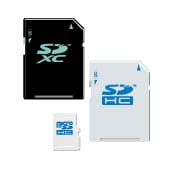The SD memory card was born in the year 2000, when Bill Clinton was completing his second term as president of the United States. Sixteen years in human time may sound short, but in electronic technology time, it is an eternity. Today, more than a billion SD memory cards are being manufactured and sold around the world every year; they have truly become the de facto standard for removable storage.
Over the years, SD technology innovations have accelerated to keep up with market demands for ever-increasing storage space and faster speeds, all at a reasonable cost. We started with the initial SD version 1.0, using FAT16 and with storage capacity up to 2 GB; then on to SD v2.0 (SDHC), using FAT32 and with storage capacity up to 32 GB; and now to today’s v3.0 (SDXC) using ex-FAT and with a massive storage capacity of up to 2 TB.
The incredible speed at which SD standards evolve is nothing short of amazing – in fact, the SD Association just announced the latest version: 5.0, with new Video Speed Classes to satisfy the latest 4K/8K Ultra HD video, 360-degree video and multi-file recording demands.
But even though the consumer electronics and digital imaging markets drive the leading edge of SD technology innovations, there remains a strong and healthy demand for older generations of SD memory cards, namely SD or SDHC memory cards varying in capacity from 128 MB up to 8 GB.
The need for older cards
Some applications, like 4K/8K video, require SD memory cards with blazing-fast transfer speed for highest bandwidth and throughput. Other applications need cards with large amounts of data storage, such as those storing 360-degree video. Consumers, meanwhile, demand the lowest cost per gigabyte. There are still use cases, however, that don’t need these bells and whistles – such as applications in industrial segments that run on variants of Linux or Windows Embedded OS, or Real-Time OS (RTOS) such as WindRiver VxWorks and QNX.
Instead, industrial and embedded markets such as factory automation, enterprise mobility, transportation, telecom/networking, healthcare and industrial IoT require SD memory cards to be rugged, highly stable data storage devices, capable of enduring harsh environmental conditions, such as extreme temperatures ranging from -40° C to 85° C.
These markets do not need terabytes of storage space; a few GB or even 512 MB or lower can satisfy their data storage needs. For example, an SD memory card might be used as a boot device with a small amount of data logs for a wireless base station in the high mountains or the middle of the desert.
 Sample markets where older SD memory cards are still popular
Sample markets where older SD memory cards are still popular
Furthermore, as deployment to the field could last five to 15 years, these SD memory cards’ bill of materials (BOM) is expected to be maintained over this period of time, or at the very least, the manufacturer should have controlled management of its supply base. The longevity of the supply plays a crucial role in the vendor selection process.
Another key consideration is SD memory card customization to suit the specific application’s storage usage model based on the nature of the NAND flash process technology – for example, whether the card is based on SLC (single-level cell), MLC (multi-level cell), TLC (triple-level cell) or another variant of NAND.

Examples of features from older SD standards that are still relevant and required include:
- SPI mode. SPI, or Serial Peripheral Interface, is a synchronous serial protocol that is extremely popular for interfacing peripheral devices with microcontrollers, on which many industrial systems are based. For years now, many industrial systems have interfaced with SD memory cards using SPI mode, and host system designers do not want to make any changes to the system software and device drivers for ease of implementation, adoption and risk mitigation. In addition, the microcontrollers supporting 3.3V makes SPI mode relevant for SD storage on these host devices.
- File systems: FAT16 and FAT32. Many legacy host systems are still running on FAT16 or FAT32 only. This makes legacy SD memory cards relevant, and it is critical to find the right supply base.
How to choose a vendor supplying older SD cards
It’s increasingly difficult to find older SD memory cards that meet industrial applications’ requirements because many SD memory card manufacturers focus on consumer electronics and digital imaging markets.
There are a few tips to consider before you select an SD memory card maker:
- Technical know-how and support: Does the manufacturer have easy-to-reach support staff to help you with SD memory card function and technology questions? This will allow you to choose the right SD memory card size and technology for your needs, which could include write endurance, performance under extreme environmental conditions or both.
- Supply chain management: Does the vendor have a long-term supply chain management system and processes such as controlled or fixed BOM in place for systems that may be deployed up to 15 years?
- Company focus: Is the manufacturer’s business model focused on long-term support and engagement?
- Environmental considerations: Does the vendor provide SD memory cards that can withstand the extreme and harsh conditions where they will be deployed?
- Customization: Does the vendor have the capability and willingness to perform firmware customization based on your system and application need?
- Application and industry-specific validation testing: Industrial market segments, where these older cards are used, have a high variance of application/usage models. Does the manufacturer have the capability and willingness to provide the testing to comply with industry standards such as IPC, JEDEC, AEC-Q100 or MIL-STD?
- Additional NAND flash testing: Can the manufacturer provide additional testing on the SD memory cards specific to the NAND flash used, such as a power cycling test and product lifetime simulation?
Finding older SD memory cards is no longer as easy as going down to your local electronics store. There are, however, a handful of SD memory card manufacturers that still offer older SD memory cards and services to support specific industrial markets. Asking the right questions and looking in the right places will ensure that you get the right SD memory card for your applications.
Danny Lin is the vice president of ATP and board member of the SD Association. At ATP, Lin is responsible for global supply strategic partnerships and alliances. With the SDA board of directors, Lin is driving the continuous expansion of the SD memory card adoption in non-traditional markets, including IoT, Industrial/Embedded, Healthcare and Automotive. Lin can be reached at DannyL@us.atpinc.com.



